Development
of tourism industry in
Nepal
: possibilities and challenges
Prakash
Ranjitkar
Malangwa-8,
Sarlahi
Tourism
is a priority sector of His Majesty’s
Government (HMG) of
Nepal
. Tourism has enough potential to uplift national economy and change the
citizens’
status. Of
course, it needs combined efforts so that other components of the national
economy also grow simultaneously to achieve the goal of balanced development.
Tourism has been
established as one of the dominant activities in world economy from the
beginning of 21st century. In 2001, about
693 million
visitors traveled from, one country to another, making tourism one of the top
categories of international trade. It
generates around 3 trillion USD
per year in
total revenues around the world. It has been estimated that the number of
visitors will grow to a level of 937 million by 2010.
Nepal
has over three decades
of experience in tourism sector after establishment of Nepal Tourism Committee
in 1970 followed by a Tourism Master Plan in 1972 and establishment of Ministry
of Tourism in 1973. The number of tourist arrivals has drastically increased in
past few decades with around 6,000 tourist arrivals in 1962, increased up to
about 400,000 by 1996. At present, tourism sector is a major contributor in the
national economy. Around three quarter of merchandise export and one quarter of
the whole foreign exchange earning is coming from the
tourism sector.
There is no doubt that tourism has remained one of the buoyant sectors of the
Nepali economy. The nature
and environment
has remained major attraction of
Nepal
’s tourism industry. Tourism has not only created jobs for the rural and urban
population in Nepal by expanding local craft and trade but also help build the
local infrastructure and foster a sense of pride for a particular region. Thus,
on the whole, it has helped to stabilize and diversify the rural economy.
Nepal
has a lot to offer and satisfy a wide variety of tourists choices
e.g.
nature and environment tourism (visit to nature conservation sites, national
parks, wildlife
safaris,
jungle resorts etc), adventure tourism (mountain
climbing, mountaineering expeditions, mountain treks, camping, anti-port
adventure, water
adventure etc.), religious tourism (visit to pilgrimage and religious sites for
Hindu and Buddhist), cultural tourism (cultural and ethnic life style experience
programs, visit to world heritage sites), luxurious holidays (holiday package
tours and special interest products e.g. gambling in casino, holiday in jungle
resort etc).
Nepal
has witnessed sudden
but obvious influx of international tourists that led to development of tourism
from top-down approach instead of the preferred bottom-up approach. The stabilization
and strengthening of domestic tourism is important to provide a durable
foundation support for long-term growth of international tourism. There are
several places with historical significance but cannot be established as popular
tourist destination due to geographical reasons. The emotional attachment of
domestic tourists to historical events and places will help to promote such
places as domestic tourist market that will help to preserve their heritage.
While
talking intra-regional tourism,
Nepal
received about 27% (in 2000) of its total arrival from the SAARC region. The
tourists from
China
are still confined within the 1.5% (in 2000) of the total share. While other
countries of the region receive insignificantly low arrivals from the regional
share. The prevalence of Hindu socio-cultural practices in
Nepal
and the large population of Indian Hindus promise an encouraging scope for
religious and pilgrimage tourism. The Buddhist population of
Sri Lanka
and also South East Asian countries can be attracted to Lumbini (the birth place
of Buddha) and various other Buddhist shrines. The increased tendency of SE
Asian people to travel due to improved economy has opened the possibility of
extension
of
inter-regional tourism. At present, tourist arrival from these countries are
very low except in case of Japanese tourists, which is about 9% (2000) of total
arrivals.
Quality tourism is
a sustainable tourism development that meets the needs of the present day
tourists and host regions while protecting and enhancing opportunity for the
future. It is envisaged that it will lead to the management of all resources in
such a way that economic, social, and aesthetic needs can be fulfilled while
maintaining cultural integrity, essential ecological processes, biological
diversity, and life support systems.
While
promoting mass tourism, social and cultural impacts should be considered
carefully. There are several problems associated with development of tourism.
There are several examples of tourism being a prominent factor to damage
indigenous way of life and cultural values of the host countries.
Mt.
Everest
and Lumbini (the birth place of Lord Buddha) are unique attraction of
Nepal
’s tourism industry.
Eco-tourism
is another popular concept widely discussed that strikes at balance between
nature and human beings to ensure co-existence of both. It is basically a
participatory process to minimize negative impact of tourism on nature giving
more priority to local conservation and development efforts.
Nepal
’s main ecotourism sites are the Himalayan area
such as the
Annapurna Conservation Area and the Sagarmatha (Everest) National Park, the
wildlife reserves in the southern Terai jungle, including Royal Chitwan national
Park. These sectors alone are responsible for 25 % of tourist income in
Nepal
.
The
Visit Nepal Year 1998 (VNY) programme had targeted to attract 500,000 tourists.
Although the target was not met it was a good experience to organize similar
programmes in the years ahead. HMG has decided to observe the Destination Nepal
Year (DNY) beginning from mid-2002 with the target of attracting one million
tourists. Given the national and international developments since the end of the
VNY programme, the target seems to be very ambitious.
The
year 2001 has witnessed around 16 % decline in tourist
arrival over
last year. The
deteriorating political and security conditions in
Nepal
can be held responsible for these recent downfalls in tourism industry.
Political stability and peace are desired preconditions for full flexure
development of national economy. Besides this a proper development strategy is
an important factor for well-balanced and long-lasting development.
Unfortunately,
Nepal
has already failed to maintain its previous image of a peaceful country mainly
due to political instability and rise in violent activities in last few years. It
is high time for
Nepal
to stop violence and divert its energy in reestablishing a peaceful country not
only for tourism development but also for overall development of the country.
ネパールで知った歩く旅の魅力(エコツーリズムへのヒント)
依田明実(北海道大学 地球環境科学研究科 院生)
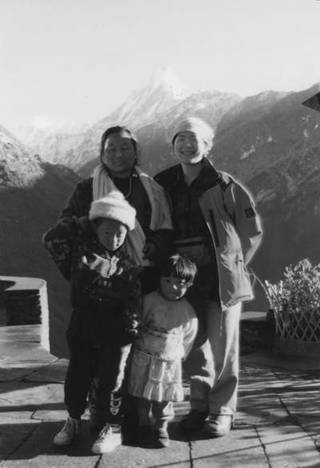 私が初めてネパールに行ったのは、1995年の年の瀬であった。アンナプルナ・ベースキャンプへのトレッキングツアーに参加したのである。
私が初めてネパールに行ったのは、1995年の年の瀬であった。アンナプルナ・ベースキャンプへのトレッキングツアーに参加したのである。
ポカラからバスで移動し、フェーディー(Phedi)から歩き始めた。初めは、畑の中に家がたたずむ里山的な風景の中を行く。風景は、毎日、徐々に変わり、シャクナゲなどの林から、灌木、そして雪と岩の世界に変わっていく。
ルートは、登山道という感じだが、集落の中や周辺では、石畳になっているところもある。人々が行き交うだけでなく、羊や牛などの家畜も利用している。上り下りが激しく、対岸に渡るために、山をぐっと下って、橋を渡り、再び登り返すこともあった。
ある時、ふっと来た方向を振り返ってみると、前の晩に泊まった集落が、後方、対岸にそびえ立つ山の中腹に見えた。その時、「人間の移動距離というのは、こんなものなのか。」という気持ちになった。その距離に対しては、長いとも短いとも思わなかったが、普段、日本に暮らしている時には見えなかった距離の発見であった。また、これは、日本に戻ってきてから気づいたのだが、渋谷の繁華街を歩いている時に、妙な違和感を覚えた。人混みは、言わずもがなだが、自分の目の焦点が、煩雑で派手な看板や建物ではなく、かなり遠くに合っているようなのである。10日間ほどのトレッキングで見つめていたのは、足下と、遠くにそびえる山や空。自然と遠くを見るくせがついてしまったのかもしれない。
このツアーのグループには、野生生物に詳しいメンバーがいたため、言われるまで気がつかなかった、猛禽類や哺乳類を認識することもできた。ネパール人のスタッフからは、ネパール語の単語や言い回しを教えてもらい、ゲームや踊りなども教えてもらった。
エコツーリズムのモデルについて考える時に、浮かんでくるイメージの一つが、このトレッキング体験である。歩くこと、つまり時間をかけて過ごすことから見えてくることがあり、自分の感覚と語り合える一時を持つことの大切さ。そして、安全性はもとより、好奇心を満たし、また、疑問がわいた時には、解消の手助けをしてくれるガイドやガイドブックなどの存在。さらに、その場所でしか味わえない味や、言葉、踊りを体験できること。そして、最後に、地域やホストしてくださる方々に対して、Takeするだけでなく、お返しにGiveできることは何なのかを考えること。
国内の混乱が早くおさまることを祈っています。
Fascinating
trek to
Nepal
- my first trip and some thoughts for ecotourism
Akemi
YODA
Graduate
School
of Environmental Earth Science,
Hokkaido
University
My
first trip to
Nepal
was in 1995. I was in the trekking group to Annapurna Base camp.
The
bus took us from Pokhara to Phedi from where we started walking. Villages in the
field, rhododendron woods, steep slope, bushes, snow and rocks...the scenery
changed every day.
Some
trails in and near the villages were paved with stones. We saw sheep, cow, yaks
and other livestock on the trail. There were very steep sections. We had to
climb down the very steep trail to go across a bridge and then we went up the
steep hill of the other side of the river.
One
time I turned back, and what I saw was the village we stayed at the night before
on the steep hillside far away. Then I recognized the distance I could walk in
one day. I never had a chance to confirm the distance with my own eyes how far I
could walk in one day, so the distance was a discovery for me. When I came back
to
Japan
and walked on the crowded streets in
Tokyo
, I had a funny feeling as if my eyes were not focusing on the objects around
the street. Then I realized that what I saw during the trek were mountains and
skies in far distance. My eyes have got longer focal length.
We
were lucky to have a member who had a rich knowledge of wildlife, and we could
identify some raptors and mammals. Also we learned Nepalese words and short
phrases and games and dances from Nepalese staff members.
My
research topic is ecotourism, and when I think about ecotourism model, one of
the images comes to my mind is this trekking experience in
Nepal
. One can find many things when you walk (move slowly), otherwise one won't
notice. One can develop senses hardly used in daily life. Besides ensuring
safety, it is important to have guides or guidebooks to help answering one's
questions. Cultural experience is also an essential part of ecotourism. Finally
it is important to think how to contribute to the people and the area in return
for what one could obtain during the trip.
I
hope for the early return of peace in
Nepal
.
NGOs
and women empowerment
Vijaya
Acharya
Lainchaur,
Kathmandu
The
growth of Non-Governmental Organizations (NGOs) operating in the third world is
enormous nowadays. Three major reasons-societal conflicts and tensions; the need
to respond more effectively to the crisis coming from the breakdown of
traditional social structures; and ideological and value differences to the
planning and implementation of development works– can be noted as relevant for
the NGO evolution.
In
the nongovernmental development schemes, there are three clear and distinct
participants: Grass-root Organizations (GROs); Local and National
Nongovernmental Development Organizations (NGDOs), which cater to the multiple
needs of grass-root sectors; and International Development Cooperation
Institutions (IDICs), which are international NGOs, solidarities or funding
agencies.
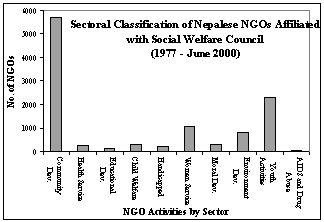
Source:
Directory of NGOs in
Nepal
, Social Welfare Council,
Kathmandu
, 2000.
Along with lessening
government’s role in economic activities during economic liberalization and
globalization, government’s role in social activities has also becoming less
over the years in many developing countries despite tremendous needs of
investment in socio-economic development infrastructures. There are gradual
efforts to fulfill those gaps by the NGO activities. They work in both hardware
and software aspects of development infrastructures. Majority of NGOs work in
latter aspect, aiming at empowering socially and economically deprived section
of the society, which is always a big chunk in the countryside of an
underdeveloped country, and basically they are women. Thus, the term empowerment
mostly refers to women empowerment.
The
economic empowerment refers to the access and control over economic resources,
whereas the social empowerment refers to the civil rights, awareness and
liberty. Though these issues are difficult to measure, some major social
development indicators are being used to meet this purpose, for example,
literacy rate, legal rights of women, basic health indicators, etc.
Issues
At
the core of all empowerment efforts, the basic objective remains how to make the
target group self-reliant. Though promoting economic self-reliance of the
deprived generally becomes the focal point in the empowerment process, the
socio-political empowerment can also not be ignored as they ultimately translate
into economic empowerment.
Since
the decade of eighties, economic liberalism is developing in parallel with
social liberalism. In many development activities, non-government sectors have
been promoted, the role of them is basically to reach rural poor population and
help develop human development infrastructures. In these concurrent movements of
government and non-government activities, government mainly builds physical
infrastructures and the non-government organizations mainly work for social
welfare. The domestic NGOs in many countries are working in almost all areas of
development whereas the international NGOs are working in the areas of social
aspect of development in general and economic aspects in particular cases.
In
Nepal
also, the I(NGO) activities especially flourished since the beginning of the
1990s. Since the non-government activities are to meet the development needs,
their activities are also of varying nature (see the graph for major activities
of NGOs in
Nepal
) so that it is quite difficult to merge them into a common denominator.
NGOs
working in the areas of community development, women services, environmental
protection and youth activities are over 8000, constituting approximately 80% of
the total NGOs in the country. The community development activities basically
focus on deprived section of the society, mainly illiterate women, disables and dalits,
indicating that the major concern of NGOs is to empowering these sections of the
community.
Challenges
and forward move
NGOs
are facing a challenge to organize themselves to work in more global and
strategic ways in the future. NGOs are addressing such challenge by integrating
micro and macro-level action in their projects and advocacy activities. The
changing global context challenges is making them adopt this natural way of
working. Recently, in the ground of empowerment, many NGOs have to work among
destitute poor women where the resource generation is virtually absent in one
hand, and have to compete in the more competitive world for winning the
resources, on the other. Working with dual strategies of security and
competition at the same time is really a challenge.
Moving
from development as delivery to development as leverage is the fundamental
change that characterizes this shift, and it has major implications for the ways
in which NGOs organize themselves, raise and spend their resources, and relate
to others. NGOs must build outwards from concrete innovations at grassroots
level to connect with the forces that influence patterns of poverty, prejudice
and violence, exclusionary economics, discriminatory politics, selfish and
violent personal behavior, and the capture of the world of knowledge and ideas
by elites.
Do
you know which vegetable is the best for your health?
Megh
Raj Bhandari
Prakashpur-6,
Sunsari
Consumption
of fresh vegetables has been associated with the prevention of chronic
diseases such as cardiovascular disease, cancer, aging, and several others
in humans. A significant inverse correlation has also been reported between
total vegetable intake and cerebrovascular disease mortality. Food scientists
indicated that a constant supply of vegetable with desirable health benefits
is essential beyond basic nutrition to furnish the defensive mechanism to
reduce the risk of chronic diseases.
Among
the most commonly consumed 10 vegetables, namely, Broccoli, Cabbage,
Carrot, Celery, Cucumber, Lettuce, Onion, Potato, Red pepper and Spinach,
following is the suggested reference order for consumers to choose on the
basis of their health promotional (Bioactivity Index) activities.

Reflect
works in
Nepal
Manvi
Bista
Manbhawan,
Jawlakhel,
Kathmandu
Reflect
is an innovative approach to adult learning and social change, which blends the
theory of Paulo Freire
(1921-1997) with the methodology of participatory rural appraisal (PRA)
while working with the community. Paulo Freire was a Brazil-born educator, who
is renowned for his struggle to liberation of the poorest of the poor, the
marginalized classes that constitute the culture of silence in many places. His
philosophy on culture of silence is a characteristic attributed to the oppressed
people, who would internalize their images negatively (images created and
imposed by the oppressor) and feel incapable of self-governance.
As
pilot projects, the Reflect approach was first applied in
Bangladesh
,
El Salvador
and
Uganda
. Since then it has expanded, diversified and adapted to the multitude of
contexts in which it is adopted. It is now being practiced over 60 countries in
the world.
It
was adopted in
Nepal
in 1995. This was the time when most of the NGOs, INGOs were frustrated with the
performance of the conventional adult literacy program and were in need of an
alternative. It was introduced as a pilot action research in three districts of
Nepal
and was evaluated later. It was proved to be more effective than adult literacy
programme with primer-based methods, though both of them were working for
literacy with empowerment. In addition to it, the former also increased
people’s participation in community organizations. These encouraging
results of pilot projects led to the expansion of Reflect works, and now reached
to 30 districts.
Key
features
In
contrast to the conventional adult education program, which is fully focused on
'literacy learning circle'; Reflect is rather a 'social or community forum',
which provides people with a framework for critical self and social analysis.
The Reflect Approach also provides a 'basket of tools and techniques' for this
analysis. It helps create a democratic space and culture, which can facilitate
the process of critical analysis.
In
addition to literacy, this approach also emphasizes on organizing the community
for collective reflection about various aspects of their lives. The
Reflect Circle
becomes a social forum to identify problems and explore new opportunities.
People's
rights-focused Reflect practice
Nepal
is
among the few countries in the world where Reflect work has special focus on
improving civil society organizations and networks for enhancing peoples'
rights'. The literacy component may still be there, but it is not taken as the
prime objective. Instead, rights-based approach to social change and development
is stressed. It has helped people
in building or strengthening their organizations, which aim at protecting
peoples' basic rights. Reflect has also helped people and communities critically
analyze people's rights, identify ways to organize, as well as educate and
empower deprived groups and communities.
Dalit
movement of Sapatri: a case of Reflect work in
Nepal
The
early stages of organizing dalits in Saptari District were greatly facilitated
by the structure created by Reflect Centers. In 1998, 15 women centers
were launched to establish women network and provide them an opportunity to
identify and discuss issues related with their skills, and develop confidence as
well as leadership. In their meetings, the women began conducting an analysis of
the caste system and the situation of women. Groups also discussed the
importance of creating an action plan to counter discrimination and identified
the need to develop an organization to create group strength. In response,
eight women’s Sanghams (organization) were formed.
Groups
themselves served to break down caste barriers, raised the participants’
self-confidence and dignity. The rigid caste discrimination (between dalit
and non-dalit women; for example, when the Reflect classes were started, dalits
had to sit outside the class and were not allowed to use the same water tap or
share food with the non-dalit class members) existing at the beginning began to
break down. This motivated in-depth analysis and discussion on rigid caste
divisions in the Reflect circles. Barriers were gradually broken down and
conscious changes were made to rectify the unjust treatment over the dalits.
After some time, non-dalit and dalit women started to mingle around, share food
and sit together in a common class. This in itself was a major achievement
over the stringent cultural taboos surrounding the caste behavior.
The
turning point in the development of the dalit movement in this area was
Sangham’s decision to abandon their traditional jobs to throw carcass as
vested by the caste system. Although carcass throwing was a job relegated
only to the chamar (shoemaker) caste, Sangham was able to unite the castes in
supporting the ban because the job was a perfect example of the caste-based
exploitation and discrimination against dalit. This directly challenged
and attacked to the roots of the caste system and provoked a new level of
opposition by the high caste community. Realizing this, participation in
sangham groups from dalits got increased and thus the dalit movement gained
momentum. The dalit communities’ solidarity, and ultimate victory in
sustaining the boycotts, confirmed their faith and commitment to the movement,
helping attract new members and spreading the dalit movement throughout the
region.
Experience
shows that grassroots empowerment work is very important though it has many
limitations. In order to establish deprived people's fundamental rights in
society, people's movements need to address several issues of governance that
are affected by national and global decisions. Dalits
in
Nepal
have started becoming more organized than they were in the past. The restoration
of democracy in 1990 may have attributed to this change significantly. The
credit also goes to Reflect works in making people aware about the situation and
making them ready for action on their own. However, this movement still has a
long way to go. Reflect is still as useful as it was when the movement had
started.
High
altitude geomorphic processes and their significances in the
Nepal
Himalayas
Dhananjay
Regmi
Pauwai
Gaunde-2, Syangja
The
implications of the studies on periglacial processes in high altitude
Himalayas
are questioned, as connections between high altitude geomorphic processes and
the human activities are not straightforward. An attempt has been made here to
provide a short glimpse on some of the geomorphic processes active in the high
altitude area of the
Himalaya
and the potential hazards associated with them.
Nearly
25 percent of
Nepal
’s land is under the mountain belt (3600 m – 8850 m). These mountains are of
high importance because they act as metrological barrier and, in turn, cause
rainfall in the country. Moreover, from the resource point of view, they are the
source of perennial rivers, various mineral and herbs. The splendid landscape is
also the center of attraction for developing tourism. On the contrary, these
mountains may cause catastrophic hazards like Glacier Lake Outburst Flood (GLOF)
resulting fatal consequences.
If
we observe mountains closely, it is found that the present mountain landscapes
are the result of many geomorphic processes of the long past. The processes
include snow ice avalanches; debris/mud flow and torrential floods; rockfall;
glacial lake outburst; slow mass movement; and shallow soil erosion on
grassland; they are related either with the glacial or freeze thaw processes,
and are controlled directly or indirectly by the climatic factors. The magnitude
and the intensity of these processes are increasing in recent decades because of
the so-called Global warming.
Some
of these processes are of high magnitude with low frequency i.e. GLOF, and has
tremendous effects in down stream. There are 2,323 glacial lakes in
Nepal
, out of which 20 glacial lakes were identified as potentially dangerous.
Sometimes, low magnitude geomorphological processes and resultant landscapes,
which are mainly associated with freeze-thaw actions, are eroded away by the
high magnitude processes. As a result, sediment transport during the GLOF is
exceptionally high in the high altitude areas. Furthermore, the material is also
eroded from the riverbanks, terraces, and slopes in downstream. As a result,
slope instabilities are triggered off. Impact caused by GLOF is seen to be
occurred in far downstream (>90 km) resulting sedimentation in the
agriculture land, destruction of infrastructure, etc.
In
these contexts,
the precise observation on the mountain landscapes, and the study of
geomorphologic processes could be of immense
help
to understand these processes and the rate of landscape development that may be
of high
significance
to take precaution so as to reduce the possible catastrophic damages.
Teej
2060 in
Hokkaido
,
Japan
Gita
Bhandari
Prakashpur-6,
Sunsari
"Teej"
or Haritalika is purely a women's festival. It takes place in late August
or early September. The festival is a three-day long celebration that
combines sumptuous feasts as well as rigid fasting. Through this
religious fasting, Nepali women pray for marital bliss, well being of
their spouse and children and purification of their own body and soul.
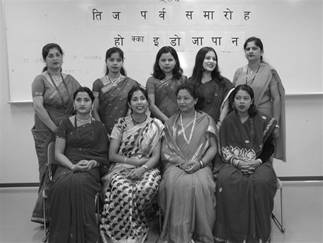
A
group picture taken during Teej Festival
Traditionally,
the ritual of Teej is obligatory for all married women and girls who have
reached puberty. According to the holy books, the Goddess Parbatee fasted
and prayed fervently for the great Lord Shiva to become her spouse. Touched by
her devotion, he made her his wife. Goddess Parbatee, in gratitude, sent her
emissary to preach and disseminate this religious fasting to women wishing
prosperity and longevity of their family’s the lives. Thus, the festival
of Teej was born.
The
important part of the Teej is called the "Dar-Khane-Din". On this day
the women, both married and unmarried, assemble at one place, in their
finest attires (mostly women are seen wearing red garments invariable and
decked in all sorts of jewellery), and start dancing and singing with
devotional Teej songs. The jollity often goes on till midnight, after
which the 24 - hour fasting commences. Some women stay without any food or
even a drop of water while others take liquid and fruit. On the third day, women
goes to river and bath with “datiwoon’ a plant with regular nodules. Teej
ends with Panchamee puja (religious ceremony) with offerings of flowers, fruits,
etc., to Shiva and Parbati, beseeching their blessing upon the husband
and family.
We,
Nepali women residing at Hokkaido Japan, celebrated Teej of 2060 BS. The program was
organized on the auspicious day of Teej (on Aug 29, 2003) at
International Plaza of Hokkaido University. All Nepali family members, including women,
men and children, participated. The program was started at 6:00 PM, by singing a
Teej song “Teej Ko Lahar Ayo Bari Lai”and later the environment
become livelier with group dance. The additional funs of this program
were couple as well as group photo sessions, jokes and musical chair
competition. Finally, we enjoyed with typical Nepali foods, as a part
of special dinner called DAR. The specialty of this dinner was: individual women
prepared particular dish. Oh! Khir, Masu-Bahat (meat and rice), Acchar,
Tarkari (vegetable), Salad, Noodles, etc., were so delicious that we really
enjoyed with these multiple tastes. Finally, group dancing with famous Nepali
folk song “Wari Jamuna Pari Jamuna” ended Teej festival around 9:00
PM.
Thanks
to all members of our HUNSA community who initiated to organize Teej
festival in foreign land, this made us feel at home. Special thanks to women
group for their contributions in preparation of food and performance of
Teej dance in typical Nepali dress “Saree and Cholo”! After all, it
has become one of the memorable events of our life: Teej Festival in
Hokkaido
,
Japan
!
Tourism
potential and Nepal
Sunil
Kumar Lama
Maharajgunj-4,
Kathmandu
Scenic
mountains and landscapes, wide biodiversity, climatic variation within of the
short distance, locally spread tribal ethnic culture are the key offerings of
Nepal
, which will be deserving more interest and contentment for the visitors to
Nepal
. The outsiders often imagine
Nepal
as the country of mountains, so obviously they might have the target to sight
its scenic view, but when they come along the step-by-step fascinating charming
of
Nepal
then they will really get the intriguing experience. It is just to explain that
Nepal
has the vast potential of tourism and in return will provide immediate response
on economical and social sector of nation and most importantly for people up to
the village level if managed and promoted properly.
The
growing interest of people to wander the undisturbed nature could most be
exploited in
Nepal
and in this context
Nepal
has to build up some basic foundation for its fulfillment. The most important in
this sector is to minimize the possible over exploitation of the natural
resources due to the thrust from the tourism and social disturbances due to the
difference in cultural and habitual behavior of the incoming guest. Medical
support and evacuation facility in the case of the emergency make use of the
local resources and skills and with most importantly the security providing
should be simultaneously addressed too. These are the most prime but not much
difficult sectors to be addressed truthfully.
Wandering
of undisturbed nature with the local living standard could provide unique
experience to the visitors and it will also help both for comfortable
interactions. It will provide both of them to know closely and share their
opinions and experience on the more natural ground without the bound of their
economic and intellectual difference. It will also make possible to have the
direct economic benefit and employment generation to the village level people.
Alternative
use of energy, information centers, hygienic condition improvement activities,
community approach for the equal sharing of benefits, capacity building
activities are the sectors where the central, local level government and non
government organization have to play crucial role with the maximum participation
of the local people on its management and the decision making.
Awareness
and capacity building of the local people should be addressed extensively as it
will decide on the success of the targeted aim. For the equal sharing of the
benefits either community based income sources could be established such as
community lodge, camping site and other recreational activities/spots or there
should be minimum standard rules and regulation for providing the facilities. It
will help for the fair contest in the community with poor economic background.
Community based management committee should play important role on the community
based decision and directives
For
the balance of the energy consumption due to the flux of the tourist,
alternative source of energy, which could be micro hydropower, solar power,
improved stove or kerosene etc, should be promoted. Micro hydro, solar power
generation could be developed with the joint contribution of village level
people and help from governmental/non-governmental organizations providing
subsidy, supervision and backstopping. Kerosene depot could be established even
through the local capacity.
So
for the actual exploitation of the nature tourism, should focus on maximum
utilization of the local resources and skill with exposing our rich tradition
and culture, in which there is no necessary to have the huge financial
investment but proper management and vision. Care should be taken that with due
of economic growth, our nature, culture and tradition should not be displaced,
which often happens, other wise we will be loosing our most thriving property
and tourism charming for the future generation.
Renewal
energy: a sustainable future for all
Bijay
Giri
Biratnagar,
Morang
The
Final Report of G8
Renewable Energy Task Force 2001
presents renewable
as
a key element
of sustainable development.
Sustainable
development that has at present been the goal of mankind and the planet
is a kind of development
that guarantees everyone
the means and
place to carry on lives and various activities attached to them without
compromising the need of future generations.
The fundamental needs of a society encompass food,
housing, health and clothing,
and in more
elaborated sense
includes education, culture, civil rights, quality of the natural environment,
leisure, etc.
Modern
fuels and electricity in today's world are not universally accessible. The
current energy system is neither
sufficient
nor affordable
to support widespread economic growth. The productivity of one third of the
world’s population is restrained
by lack of
access to commercial energy, and another one
third suffers
economic hardship and insecurity due to unreliable energy supplies. Inappropriate
energy
production
and consumption can
threaten the health and well being of current and future generations.
Thus,
today's need
is to address this global challenge of establishing appropriate energy
system.
Energy systems
The
global energy demand is ever increasing due to the increasing population and
industrialization. Most of the energy used is generated from fossil fuels, which
is now considered as a major source of man-made pollution
with eventual negative impacts like climatic
change,
global warming,
acid rain, and problems for waste disposal. In
developing countries, non-commercial
fuels like
wood and animal
dung overwhelmingly dominate household energy consumption, resulting
deforestation
and indoor pollution.
Dependence
on non-renewable resources can be regarded as unsustainable in the long term.
In this regard, promotion of renewable energy is a very important global
issue.
Renewable energy sources are
collected from
current ambient energy flows or from substances derived from them. These include
solar energy, hydropower, bio energy, wind energy, wave and tidal energy,
geothermal energy,
ocean, hydrogen fuel cells as
well as domestic and industrial wastes. Renewable
energies are considered effective
in meeting
the
environmental and developmental concerns simultaneously,
and can
supply
sustainable energy creating
very less
environmental pressure.
The ratio of
non-renewable to renewable energy resources represents a measure of a country's
sustainability. Promoting
the use of such
renewable
energy is gradually getting to be an important topic
in the recent development discussions.
Strategies
Sustainable
energy needs a long-term consideration on cost of production and the extent of
emission. Governments have a significant role in developing strategies on
shifting to such sustainable renewable energies. Phase out subsidies for fossil
fuels and re-direct funding to energy conservation and the production and
consumption of the most sustainable renewable sources of energy like
micro-hydro, wind, solar cookers, solar PV for remote areas, hybrid wind-solar
systems, and biomass is one of the interventions that the government can
administer. The macroeconomic calculations and energy policy and pricing should
include both positive and externalities of different energy sources. The
renewable energy, which has higher positive externalities, should be promoted by
various fiscal policies. The
government can also promote renewable energy by introducing various financial
strategies like micro-credit for small sustainable energy businesses and
arranging funds for research and development of sustainable energy production.
Education and training on sustainable energy not only for policy-makers in
governments, but also for the people working in intergovernmental agencies and
major groups in civil society is very important. Such education is equally
important for the general public, and especially for primary school children.
Attaining
sustainable energy requires
a combination
of strong governmental and intergovernmental leadership in adopting policies
that promote conservation and sustainable energy production and use. National
and International
organizations and various major groups of civil society, including NGOs, too
have very critical role in attaining this.
Networking of major stakeholders in civil society should be established to share
information on sustainable energy and the transfer of energy technologies. This
can support
regional and international cooperation and technology transfer.
Wrap-up
Renewable
energy sources can contribute towards reduction in dependency of imported fossil
fuels and
meeting the
energy demands and provides national energy security.
Renewable energy sources assume special significance in the country like
Nepal
when viewed in the context of the geographic diversity and size.
Besides
increasing the utilization of renewable energy, sustainable
energy
development also
requires more
efficient use of energy, especially at the point of end use in buildings,
electric appliances, vehicles, and production processes.
This should be backed up with generation of new
sustainable
energy
technologies.
Since
the renewable energy resources are diffuse and decentralized, they are more
appropriate in meeting basic energy needs of the rural poor. The operational
cost of renewable energy is often very low and at times even zero, through their
initial capital costs are often at present higher than those of conventional
energy technologies. If locally
available sources are used to tap renewable energies, local control can be
enhanced. In
this manner, renewable energy can be utilized to supplement or gradually replace
conventional energy in meeting energy needs in an equitable and sustainable way.
Evolution
of hard disk drives and giant magneto
resistance read head sensors
C.L.S.
Rizal and Y. Ueda
Muroran
Institute of Technology, Muroran
Hard
disk drive is one of the essential components of modern-day personal computers.
The first storage medium used on computers was actually paper; holes
were punched into paper tape or cards to record data. A beam of light was used
to read: where a hole was found it read “1”, otherwise “0”. The
evolution so advanced that modern hard disk drive, which employs magnetic
multilayer films, has no physical contact between the read head sensor and
surface of the hard disk.
|

|

|
|
|
Fig.
2
Platter showing Tracks/Sectors
|
A
hard disk uses round flat disks called platters, coated on both sides
with a special media material designed to store information in the form
of magnetic patterns (Fig. 1). The platters are mounted in the center by
cutting a hole and stacking them onto a spindle. The platters rotate at high
speed, driven by a special spindle motor connected to the spindle.
Special electromagnetic read/write devices called heads are mounted onto sliders
and used to either record information onto the disk or read information from it.
The sliders are mounted onto arms, all of which are mechanically
connected into a single assembly and positioned over the surface of the disk. A logic
board controls the action of the other components and communicates with the
rest of the personal computers (PCs). Each facade of each platter on
the disk can hold tens of billions of individual bits of data. Each platter has
two heads, one on the top of the platter and one on the bottom, so a hard disk
with three platters (normally) has six surfaces and six total heads. Each
platter has its information recorded in concentric circles called tracks
(Fig. 2). Each track is further broken down into smaller
pieces called sectors, each of which holds 512 bytes of information.
Sensitivity
of magneto
resistance (MR)
The
field dependence of magneto-resistance ratio with the current flown
perpendicular to the magnetic field is shown in Fig. 3. The electrical
resistance of the thin film prepared by electro -deposition method
decreases on the application magnetic field. There is a sharp decrease in
electrical resistance of the multilayers or thin films on the application of the
magnetic field which is referred to as sensitivity. The sensitivity of the
multilayer films [Co10 Å-Au10 Å]40 as shown in the figure is about
1.5% at the magnetic filed of 20 kOe. The more the sensitivity, the better the
performance of the read head sensor.
A
sensitive change in resistance, discovered as giant magnetoresistive (GMR)
in the late-1980s, was noticed in the late 1980s when the material was subjected
to magnetic fields while working with large magnetic fields and thin layers of
various magnetic materials; the discovery of GMR effect formed the basis for the
development of present hard disk drives.
The
structure of present GMR head assembly is shown in Fig. 4. Furthermore, a
key advance was the discovery that the GMR effect would work on multilayers of
materials deposited by various preparation techniques. The hard disk products
using GMR heads were first produced commercially in December 1997.
|
|

|
|
Fig
3
MR ratio as a function of field (H)
|
Fig.
4 Structure
of a GMR head
|
|
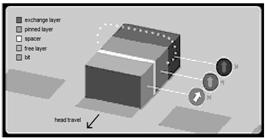
|
Upper
(+) values represented as “1” and lower (-) negative as “0” and
vice versa

|
|
Fig.
5
Conceptual Operation of a Sensor
|
|
Previous
hard disk heads were working by making use of the two main principles of
electromagnetic force. The first is that applying an electrical current through
a coil produces a magnetic field; when writing to the disk. The direction of the
magnetic field produced dependent on the direction of the current flow in the
coil. The second is the opposite that applying a magnetic field to a coil will
cause an electrical current to flow; when reading back the previously written
information. Again here, the direction of the current flow dependent on the
direction of the magnetic field applied to the coil. Newer MR/GMR heads don't
use the induced current in the coil to read back the information; they function
instead by using the principle of MR,
where certain materials change their resistance when subjected to different
magnetic fields. The heads are composites that include a different element for
writing and reading. This design is more complicated to manufacture, but is
required because the MR effect used in these heads only functions in the read
mode. Having separate units for writing and reading also allows each to be tuned
to the particular function it does, while a single head must be designed as a
compromise between fine-tuning for the write/read function.
Conclusion
Giant
magneto-resistance / Spin Valve heads are superior to conventional MR. The
sensitivity of the modern GMR/Spin Valve Sensors used in the modern personal
computers lies in the range of 5% to 8%, which is almost four times higher than
the older MR heads. GMR heads used in the latest technology drives have
capacities of up to 75 GB and areal densities of approximately 10 to 15 Gbits/in2.
As of 2002, the development of an advanced GMR head for reading data on hard
disk drives with recording densities of 300 gigabits per square inch (Gb/in2)
and greater has already been successful in
Japan
. The innovative technology displays that there will be eventually an individual
2.5" hard-drive units to have capacities in the range of 160 to 360
gigabytes, with commercial introduction of the novel read-head technology within
the next few years period.
Multiple
uses of Artemisia species in Japan and Nepal
Krishna
H Gautam1,
Chieko
Imakawa2
and Teiji
Watanabe1
-
Graduate
School
of Environmental Science,
Hokkaido
University
-
Ishikari
,
Hokkaido
日本とネパールにおけるヨモギの多様な利用
クリシュナ・H・ゴータム、今川智恵子、渡辺悌二
要約
日本とネパールでよく見られる植物のヨモギは、精神面でも物質面でも利用され、役立っている。昔ながらの方法で家庭の中でしかヨモギを利用していないネパールに対して、日本ではヨモギからさまざまな製品が作られている。ヨモギを製品化することになれば、ネパールの農村の人々に雇用の場が提供され、収入にもつながり、結果的に経済状況の変化を期待することができるようになる。日本との経験の共有はネパールの発展に貢献できること大となろう。ヨモギの製品化の研究と促進に際し、日本の協力を示唆するものである。
Summary
Mugwort
(Artemisia spp.), common plant in
Japan
and
Nepal
, has been valuable species for spiritual and material uses. Various products
are produced from mugwort plant in
Japan
, whereas it is still limited to traditional and domestic uses in
Nepal
. Industrial use of mugwort plant may change the economy of rural people in
Nepal
through generating employment and income. Sharing Japanese experiences could be
a great contribution to the development of mugwort products in
Nepal
. Further research and development of mugwort plant product is suggested.
Introduction
Artemisia,
a shrubby
species, is distributed widely in different geographical regions. International
Plant Name Index Query (http://www.ipni.org/ipni/query_ipni.html) showed 2058
entries for genus ‘Artemisia’, reflecting richness of species and
varieties of Artemisia genus.
A. vulgaris and A.
Montana are widely distributed in
Nepal
and
Japan
respectively. These two species look alike based on their appearances, sizes and
overall site-characteristics; however, genetic closeness cannot be claimed
without further investigation. Vernacular name for Artemisia
species is ‘mugwort’, and this study considers that mugwort represents
both the species cited earlier. Mugwort plants are used for spiritual and
material needs by many races around the world. We attempt here to list the
different uses of these
plants in
Japan
and
Nepal
. As the present paper constitutes a part of the study on Ainu’s indigenous
forest management practices, the information relating to the uses in
Japan
were collected mainly from Ainu’s homeland
Hokkaido
, the northernmost
island
of
Japan
.
Mugwort
plant, ‘yomogi’ in Japanese and ‘noya’ in Ainu languages,
is called ‘pati’ or ‘titepati (bitter-leaf plant)’ in
Nepal
. Different uses of mugwort in
Japan
and
Nepal
are detailed
in the next section.
Evolution
of mugwort
use
in
Japan
The
major traditional uses of mugwort by Ainu people are listed below; however, the
present-day continuations of such uses are yet to be investigated.
a)
Ainu
people have high spiritual value associated with mugwort plant. They believe
that the stems and leaves of mugwort plant protect them from the demons of
sickness related to smell. This belief was based mainly on the smell of Artemisia,
which they think would discourage the demons to come near that plant.
b)
Mugwort
was used for treating people with psychogenic disturbances. The patient had to
be slapped with the plant while shouting ‘hussa!’,
‘husse!’ or ‘hus!’ for chasing the devils away. Chasing started
from patient’s head to down through to the feet, and repeated the process
through back.
c)
Heat and
smoke from mugwort-stem fire are
thought to be
effective in purifying the person affected by psychogenic disease. Withered
mugwort stems were bundled and piled for forming six house-like objects on the
riverbank. Once the objects were on fire, the patient was forced to pass 12
times through fire (to and fro for 6 times).
Dr
Kayano Shigeru, a prominent Ainu researcher and President of Kayano
Shigeru’s
Nibutani
Ainu
Museum
, wrote in one of his books on Ainu culture “Mountain silkworm (empikki)
was one of the most disliked worms in Ainu community. Ainu people considered
the sighting of an empikki as the omen of bad things. So when they
happened to see the empikki, they beat it to death and stuck it through
the body of the empikki with the 3-years-old dried mugwort stick (riya-noya).
Ainu believed the empikki would never come back to life (revive) after
that.”
d)
While
walking/working in the places where devils were thought to be present, Ainu
people used to put branches of mugwort on their head, usually along two ears
wrapping by a scarf, and facing the upside of the branches forward (see figure
below).
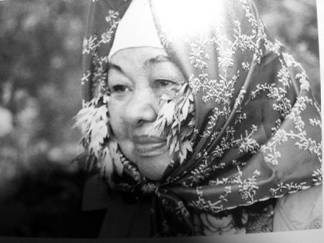
An
Ainu woman with mugwort leaves (Copied from a publication of Foundation for
Research and Promotion of Ainu culture)
e)
Ainu
people consider that mugwort has special power to chase devils away; they
believed that eating stems and leaves (decocting and drinking leaves and stems
of mugwort) drove the disease god away, effectively protecting against any
parasite into their body. They used to eat rice gruel and the leaves and stems
of mugwort (sprinkling sliced young leaves over rice gruel boiled hot) to
prevent infection with or for vermifuge of roundworms and tapeworms. The most
reasonable method of treatment for vermifugal action was to eat regularly noya
(mugwort)-sayo (rice gruel) or to
decoct mugwort
for drinking.
f)
Mugwort
was easily available medicine for emergency hemostatic and antiseptic treatments
on cuts. Ainu people used to pick the soft leaves of mugwort growing nearby,
crush them and press them on the affected part for sometime. After that they
used to tie the leaves on with cloth, other large leaves or bark of the Betula
spp. This treatment was said to prevent suppuration.
Pharmaceutical
research has traced the anti-inflammatory action in the poultice of the leaves
of Artemisia as well.
g)
The
technique of treatment for cold (diaphoretic treatment) was called Yay
(oneself)-su (pan)-maw (steam)-kare (to cause to do).
Method followed by
boiling the
decocted mugwort in a large
pan. The patient sitting near the hearth holds the pan. Patient’s head needs
to be covered with a hood-like cloth (a blanket would be good), covering his/her
face and the pan. Then the steam/vapour causes the patient to perspire.
Sometimes the patient drinks the decoction to accelerate the process. The
process lasts for 5 to 8 minutes depending upon the steam flow and condition of
the patient. The
patient
perspires profusely.
h)
Ainu
people used to treat venereal disease such as syphilis and gonorrhoea with
mugwort plants. Washing genitals by leaves and stems of mugwort or/and drinking
the decoction were found to be effective for controlling such venereal diseases.
i)
Some eye
diseases were treated with leaves of mugwort plant. Broiled leaves of the plant
used to be attached to the eyelid of the affected eyes.
j)
Mugwort
was also said to be appropriate for relieving from dental problems. Mugwort
leaves used to be grounded and mixed with salt, then applied to the root of the
aching tooth/teeth. Sometimes boiled leaves were chewed with aching tooth/teeth.
k)
Mugwort
plant was considered as insect repellent as
well (see the
following box).
A
Japanese elder woman’s recollection
In
the early-1940s, I was visiting my elder sister’s family. The windows in
their house had nothing to stop the insects/mosquitoes coming in.
Neither the mosquito-coils were available. So we burnt the dry mugwort
stems and slept. In the morning while we could see some dead mosquitoes inside
the house, but not a single bite on us. However, I felt some discomfort with
my throat for sometime.
On
the basis of these traditional experiences, various products are developed from
mugwort plants in
Japan
. The Japanese custom of eating rice cakes containing mugwort could have been
derived from the same idea
as Ainu have, although further studies are needed to understand if the idea had
been distributed from Ainu.
Most of the
Japanese are familiar with the products, such as mochi, dango
(Japanese sweets), chiffon cakes, cha (tea), sekken (soap), essensu
(essence), zeri (jelly to apply on insect bite) and mogusa (a rice
grain-size balls used in Okyu, an eastern medical technology), from
mugwort plants.
These products
are available in departmental and convenient stores, including sweet shops and
pharmacy in city such as
Sapporo
. Besides these products, dried or fresh leaves of mugwort plant are put into furo
(Japanese traditional bathtub).
During
spring, people prepare mochi,
dango and cha from mugwort leaves for own use. Yomogi
sweets are popular in festivals like hina-matsuri (doll’s festival) and
kodomo-no-hi (children’s day). Sweet factories, such as Rokkatei, use
fresh yomogi during spring and procure frozen to use in other times of the year.
As the spring in
Hokkaido
is relatively late, sweet factories in
Hokkaido
procure yomogi in early spring from
Honshu
. However, some sweetshops (confectioners) procure frozen yomogi from a
company in Otaru, indicating the economic activities relating to yomogi
in
Hokkaido
.
Mugwort
uses in
Nepal
a)
Mugwort
has high spiritual value in
Nepal
; it is one of the most religious plants in
Nepal
, and is offered in almost all ritual celebrations. Mugwort and flower are
synonyms. Whenever people build new houses the foliage of mugwort is kept on the
ridge of the roof, so that it can
protect the
new houses from
the evils.
It
is also used extensively in spiritual treatment of patient. Local healers use
the foliage in chasing the evils away from the patient’s body.
Mugwort
flower has special importance during dashain (biggest festival of Hindu
in September/October) celebration. Senior people bless younger putting mugwort
flowers/foliages on their head. Flowering
of mugwort is also an indication of approaching dashain festival.
Author(khg)’s
recollections about Artemisia in
Nepal
hills
1.
In the
early-1960s,
I used to go with cattle in the forest during holidays (Saturdays and two
month holidays in planting/rainy season). Sometimes I used to accompany my
parents to paddy planting and weeding in the fields located in the lowland
river valley (beshi). All kids were warned not to sleep in beshi
saying them that they might get fever from evil ghost and/or witches presumed
to be living profusely in the beshi (in fact it was malaria fever).
However, someone who felt asleep badly was advised to lie on close to patighari
(mugwort bush) within the sound of the flowing stream.
*********
2.
Though there were a few local healers in our village, my parent relied most on
the one who was in his sixties (about) when I was kid. Whenever any member of
my family felt ill we used to rush to find him. He used to be busy all the
time treating patients in the village. His treatment, indeed, were very
effective. He used to prepare medicines from local plants, and used to feed
with some rituals. One day he was telling me (I don’t remember the sequence
why he was telling me) the use of pati, he was so confident
that he could treat any disease using different parts of this plant. He
further added that collection should be made in different time of the year and
also potency varies with the location. His tone was clear and demanding that I
would guess now he would had some clues to use pati for treating
serious disease, such as HIV/AIDS and cancer, too.
So I would not be
surprised
if someone finds chemicals in mugwort plants to treat HIV/AIDS and cancer
patients.
b)
Mugwort
plant is the most reliable and accessible medicine to rural people in
Nepal
for treatments of cut and wounds. People squeeze the fresh leaves of mugwort and
apply on cut wounds. They believe that the mugwort leaves’ extract heals
the cut-wound quickly by preventing infection.
c)
Mugwort
is very effective in protecting from leeches. People who have to walk or work in
leech-prone areas rub its leaves on their skin. If they find
leeches biting
on their body, they simply squeeze the leaves and drop the extract on the
bite-spot. Then the leech immediately ceases biting and vomits blood.
d)
Mugwort
foliages are kept in the room to get rid of fleas.
e)
Broom
made of its foliage is thought to be effective in maintaining healthy
environment by repelling the insects.
f)
Mugwort
is used as green manure, and more as insecticide. Usually the green foliages are
used to mulch seedbeds. Its stems are also used for support for young bean
plants, probably, presuming its insecticidal role to protect the young sprouts.
g)
Mugwort
plant is the most favourite fodder of goat, and thus contributes to the rural
economy in the hill regions of
Nepal
.
Discussion
and conclusion
Both
spiritual and material values of mugwort plant are recognised in
Japan
and
Nepal
. It can clearly be seen that the age-old spiritual values recognised the
quality of mugwort plant, especially its characteristics for repelling,
antiseptic and insecticidal uses.
Mugwort
is used as fodder for goat in
Nepal
, indicating the use of this plant in feed production, whereas no such
evidences were found in
Japan
. Furthermore, the mugwort is still used for manure and insecticide in cropland
in
Nepal
, but such practice was not observed in
Japan
. The potentiality of mugwort to use in farm for manure and insecticide could
fit in the people’s increasing concern about organic farming.
Studies
in
Japan
have confirmed the chemical contents of the plant in line with the indigenous
uses. Based on the indigenous practices, various items of food and medicine are
developed from mugwort plant in
Japan
, indicating clearly the reliability of indigenous knowledge; the instances
suggest the scope of such knowledge in other fields as
well.
Thus,
mugwort plant is now used in
Japan
for industrial use, whereas its uses are still confined in the
traditional/household uses in
Nepal
. In lack of knowledge and technology, mugwort is still seen in
Nepal
as a weed plant. In this context, transferring Japanese knowledge and technology
to
Nepal
could be an instrumental in converting the so-called weed plant to industrial
plant. As the mugwort is distributed widely in the world, indigenous knowledge
from different communities may yield substantial information on its varied uses.
Such knowledge may guide future research on mugwort, and thus further research
on the various uses of mugwort is suggested.
References
-
Gautam,
K. H. (2003): Field notes from
Asahikawa
and Nibutani trips (unpublished document).
-
Kayano,
S.
(2000): Recollections of Daily Life in Nibutani (アイヌ歳時記―二風谷のくらしと心).
Heibonsha Publishing Co., Inc.
Tokyo
pp 231+
-
Kinoshita,
Y. and Takemura, H. (1993): Studies on diseases and the medical treatments
of Ainu people. Takeuchi Publishing Co., Inc.
Sapporo
pp 168+
 私が初めてネパールに行ったのは、1995年の年の瀬であった。アンナプルナ・ベースキャンプへのトレッキングツアーに参加したのである。
私が初めてネパールに行ったのは、1995年の年の瀬であった。アンナプルナ・ベースキャンプへのトレッキングツアーに参加したのである。








